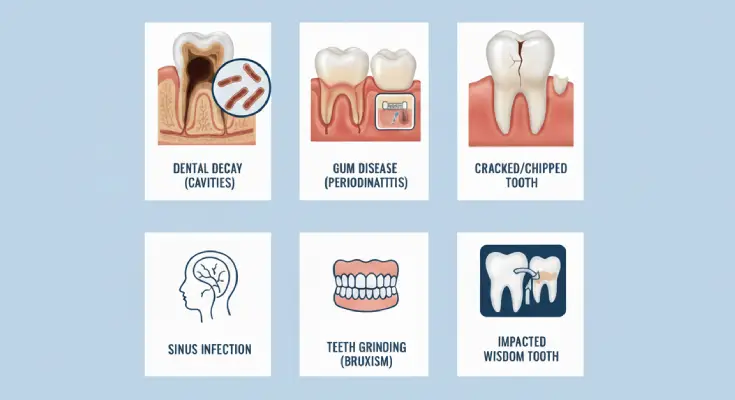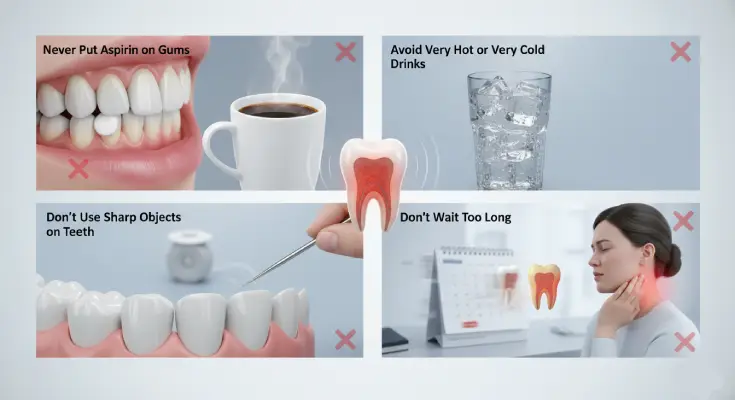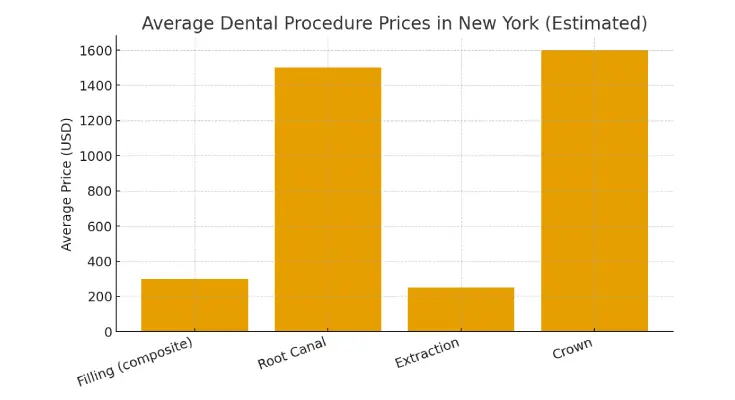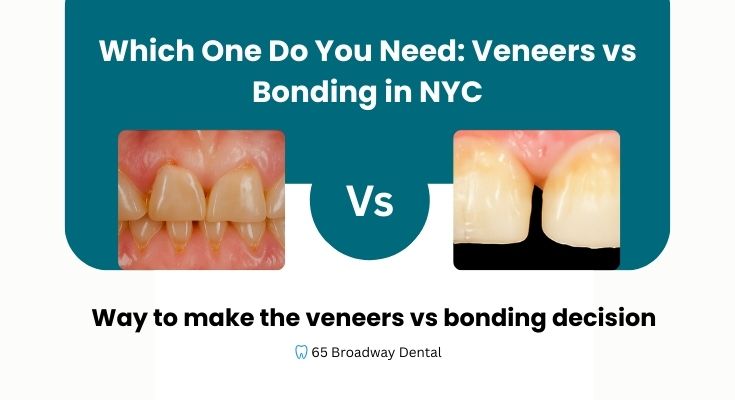How Can You Help a Toothache? Simple Fixes, and When to See a Dentist
That 3 a.m. wake-up call when it feels like a jackhammer in your jaw is something almost everyone has felt at least once. You open your eyes, grab your cheek, and wonder why such a small tooth can cause such big pain.
Toothaches are painful because the nerves inside your tooth’s pulp are highly sensitive. When there is pressure, gum bleeding, swelling, or infection, those nerves send strong, sharp signals nonstop.
If you’ve ever asked yourself, “How can you help a toothache?”, you would be glad to know there are things you can try to soothe the pain! There are a few things you can try at home to calm the pain for a while. In this guide, I’ll walk you through quick relief options you can do right now, long-term fixes that actually solve the problem, and how to know when your toothache is a sign of something serious.
And just to keep things clear, these tips are safe and proven to help temporarily, but they are not a full replacement for real dental care. You should still visit a dentist to treat the underlying cause of the pain.
Why Your Tooth Is Screaming: Common Causes
When your tooth feels like it’s screaming, it’s usually trying to tell you something. Tooth pain doesn’t just show up for no reason, it almost always means there’s a real problem that needs attention. And before you even think, “How can you help a toothache?”, you must be alert to finding out the reason behind it.

One of the leading causes is a dental carie or cavity. Germs create a small hole in the tooth, and as it gets deeper, it reaches the nerves and triggers stronger pain. Another major cause is an abscess or infection, which can create swelling or pus inside the tooth or gums and cause warm, sharp, throbbing pain.
A cracked tooth or a lost filling can also spark sudden discomfort. A tiny crack can expose the nerves to cold air, beverages, or food. Gum disease is another culprit; swollen or receding gums expose sensitive areas that hurt easily.
Wisdom teeth often create pressure when they push against nearby teeth or grow in the wrong direction. Vulnerable teeth with exposed roots can also react instantly to cold drinks or gentle brushing. Grinding of teeth (bruxism) and TMJ issues can add pressure that spreads pain to the jaw, face, or head.
Sometimes the cause is unexpected: sinus infections can make upper teeth ache, and recent dental work can initiate temporary sensitivity.
The key takeaway? Almost every toothache means something needs fixing. So when you’re asking, “How can you help a toothache?”, remaining dedicated to discovering the cause is imperative. Don’t just mask the pain; early treatment can stop bigger problems and save your tooth.
Immediate Relief: What You Can Do Right Now (Top 10 Home Remedies)
When your tooth is hurting, you want something that helps fast. These easy home remedies can calm the pain for a while until you visit a dentist. They are simple, safe, and you can do most of them right away.

1. Saltwater Rinse
A warm saltwater rinse is one of the quickest ways to feel better. Mix one cup of warm water with one teaspoon of salt. Swirl it around in your mouth for about 30 seconds before spitting it out. This mixture helps to clean and reduce swelling in the area.
2. Cold Compress
A cold compress or ice pack on your cheek can numb the pain. Wrap ice in a cloth and hold it on the painful side for 10–15 minutes. This works well for swelling or a throbbing tooth.
3. Clove Oil
Clove oil is a natural numbing agent and works to subdue tooth pain. Put a tiny drop on a cotton ball and place it on the sore tooth. It gives a warm, numb feeling that reduces pain quickly.
4. OTC Pain Meds
Over-the-counter pain medicines can help a lot. Ibuprofen lowers swelling, and acetaminophen helps with pain. Many people get good relief by using both together (safe, normal doses only). Follow the instructions mentioned on the box.
5. Hydrogen Peroxide Rinse
A rinse with 3% hydrogen peroxide kills germs and reduces swelling. Mix equal parts of hydrogen peroxide and water. Swish gently, then spit it out. Do not swallow it.
6. Peppermint Tea Bag Hack
A used peppermint tea bag can calm the area. Let the tea bag cool down, then place it on the painful tooth. Mints like Peppermint and its extracts naturally soothe and give off a cooling effect.
7. Grandma Remedies (Ranked by Evidence)
Some traditional tricks passed down for years can help a little:
- Garlic: Has natural germ-killing power. Crush it and place it gently on the tooth.
- Guava Leaves: Chew one or boil them in water to make a mouth rinse. Helps reduce swelling.
- Vanilla Extract: A little dab on the tooth can calm the nerves for a short time.
These may not be strong, but many people find small relief from them.
8. Elevate Your Head
When you lie flat, more blood rushes to your head and makes the pain worse. Sleep with your head raised using extra pillows. This helps reduce the throbbing.
9. Floss Gently
Sometimes the pain is simply from food that’s caught between your teeth. With slow, cautious flossing, you can remove anything that’s trapped there. You could receive immediate relief if food particles were really the cause.
Note: Here’s a look at the 15 Best and Worst Foods for Your Teeth if you want to avoid food-related issues.
10. Topical Numbing Gels
Medical products like Orajel or Anbesol can numb the area temporarily. They are easy to apply and help calm the sharpest of dental pains. This is a quick fix when nothing else is helping.
What NOT to Do (Don’t Make It Worse!)
When your tooth hurts, it’s easy to panic and try anything you can find. But before you rush to search “How can you help a toothache?”, remember that some things can actually make the pain worse or even harm your mouth. Here are the things you should never do when you have a toothache.

Never put aspirin on your gums.
A lot of people think placing aspirin directly on the tooth or gum will numb the pain. It doesn’t. It can actually burn your gums and make the pain even stronger. Always swallow pain medicine the normal way.
Avoid very hot or very cold drinks.
Extreme temperatures can shock the nerve inside the tooth and make the pain shoot up. Additionally, control alcohol and tobacco, as they irritate the gums and prevent healing.
Don’t poke teeth with sharp objects.
Using pins, needles, toothpicks, or anything sharp can hurt or even damage your gums or crack your tooth more. You might push food deeper or cause bleeding. If you think something is stuck, floss gently instead.
Don’t “wait and see.”
Toothaches almost never fix themselves. If you wait too long, the problem can grow bigger and more painful. A small cavity can turn into a big infection fast. If the pain doesn’t subside, even after a day or two, book a consultation with the dentist.
Red Flags: When It’s Time to Drop Everything and Get Help
Some toothaches are annoying, but others are signs of a real emergency. If you notice any of these dental checkup warning signs, don’t wait, don’t Google, don’t try home tricks, get help fast. It’s your body’s way of trying to communicate with you.
Severe pain that doesn’t get better with medicine
If pain pills don’t help at all, it often means the infection or swelling is deep. This is not normal and needs quick care.
Facial or jaw swelling
If your cheek, jaw, or even part of your neck starts to swell, and especially if the swelling is spreading, you need help right away. It could signal a severe infection.
Fever, bad taste, or pus
A fever or a bad taste in your mouth can mean there’s an abscess (a pocket of pus). This is something that needs treatment fast to keep it from spreading.
Trouble breathing or swallowing
This is a very serious emergency. If swelling makes breathing or swallowing hard, go to the ER immediately. Infections in the mouth can move quickly.
Pain after an injury
If you were hit in the face or had an accident and now your tooth hurts, cracks, or moves, you need a dentist as soon as possible.
Pain lasting more than 1–2 days or waking you up at night
Tooth pain that doesn’t calm down after a couple of days usually means something needs to be fixed. Pain that wakes you from sleep is almost always serious.
What Happens at the Dentist (So You Know What to Expect)
Going to the dentist can feel scary when your tooth already hurts. But most people feel a lot better once they know what actually happens. Consider this: you walk in with pain, and you walk out with answers, and usually with the pain already calming down.
Step 1: Identifying the Cause
The dentist’s initial step is to look closely at your tooth. Your gums, your bite, and the area surrounding the pain are checked.
Then they will take X-rays and scans. The scans give the dentist clarity to see what patients can’t, including extensive cavities, cracks, or infection under the gums.
Step 2: The Dentist Finds Suitable Treatment
Once they know what’s wrong, they find and explain the best way to fix it. Here are the most common options:
- Filling:
Used for small-to-medium cavities. The dentist cleans out the decay and fills the hole so the tooth stops hurting. - Root Canal:
For deep infections. The dentist removes the infected nerve, cleans the inside, and saves the tooth.
(The root canal process sounds scary, but most people agree that it feels like a routine filling.) - Extraction:
If a tooth is extensively damaged or infected and cannot be saved, it may need to come out. Quick, simple, and it stops the pain. - Crown:
Applying one of the 5 types of dental crowns helps reinforce a weak or cracked tooth. It makes the tooth stronger and protects it. - Antibiotics:
Given when there’s swelling, fever, or infection. They help your body calm the inflammation while the dentist fixes the real problem.
Step 3: What It Usually Costs (Simple Ballpark)
Costs change from place to place, but here’s a very rough guide:

(These numbers can be higher or lower depending on the clinic, city, and materials.)
Why Fixing It Early Saves You Money (and Pain)
Don’t be fooled by cavity myths; know that a small cavity is cheap and easy to fix.
Leave it alone → it becomes a big cavity.
Leave it longer → the nerve gets infected.
Leave it again → swelling, pain, root canal, or even extraction.
Fixing problems early almost always:
- costs less
- hurts less
- saves your natural tooth
- prevents emergencies later
Your tooth is like a tiny warning system; the sooner you listen to it, the faster you feel better.
Prevention: How to Never Deal With This Again (Mostly)
Toothaches are painful, annoying, and always show up at the worst time. The good news? Most of them can be avoided with a few simple habits. And if you’ve ever wondered, “How can you help a toothache before it even starts?”, these daily steps are your best defense. They don’t take much time, but they protect your teeth more than you think.
Brush two times a day with fluoride toothpaste.
Fluoride treatment and toothpaste help make your teeth stronger and fight early decay. Brushing in the morning and before bed keeps germs and food away so they don’t attack your teeth.
Floss like your life depends on it.
Okay, maybe your life doesn’t depend on it, but your gums do. Flossing removes food and germs stuck between teeth, places that your brush can’t reach. This is one of the best ways to stop cavities and gum problems.
Cut back on sugar and acidic drinks.
Sugar feeds the bacteria that cause cavities. Acidic drinks like soda, lemon water, and energy drinks wear down your enamel. Cutting these down even a little makes a big difference.
Wear a night guard for extensive teeth grinding.
If you have been consistently waking up with jaw pain or if your teeth appear worn down, you are probably grinding them down at night. A night guard protects your teeth so they don’t crack or break over time.
Don’t skip your regular dental checkups.
Yes, really, these visits matter. A dentist can spot small problems before they turn into big, painful ones. Getting a simple dental cleaning or tiny filling now can save you from root canals later.
Conclusion
Toothaches can feel scary and painful, but you’re not stuck. Home remedies are great for calming the pain for a short time, but they’re only a temporary bridge. The real fix, the one that stops the problem for good, always comes from the dentist.
And here’s the good news: you’ve got this. Book that appointment, walk in with confidence, and you’ll be eating your favorite foods again (yes, even steak!) before you know it. Your future self will appreciate it if you take action today.
FAQs
1. What stops tooth pain immediately?
A few methods to immediately alleviate pain from a toothache include applying an ice pack on the outside of the affected area, doing a saltwater rinse, or taking a pain-relieving medication.
2. Can drinking milk stop a toothache?
No, milk is not a reliever of dental pain. However, long-term consumption can contribute to the strengthening and repairing of teeth.
3. What happens if you ignore a toothache?
Consequences of ignoring a toothache are worsening pain, temperature sensitivity, the spreading of the infection, and ultimately, tooth loss.
4. What are the signs of tooth infection?
Tooth infections are mostly characterized by a throbbing toothache, sensitivity to cold and heat, and sometimes the pain spreads to the jaw, neck, or ear. Other symptoms that can appear include swelling, bad breath, foul taste, and fever.
5. Can tooth pain go away on its own?
Tooth pain can subside on its own if temporary irritation is the underlying cause. However, when there’s another issue behind the toothache, it’s unlikely to go away on its own.

Dr. Alexander Heifitz (Author)
Dr. Alexander Heifitz is the founder of 65 Broadway Dental in NYC, where he combines advanced dental expertise with a patient-first approach. He specializes in cosmetic and restorative treatments such as dental implants, veneers, Invisalign, and smile makeovers, helping New Yorkers achieve both oral health and confidence.
Booking An Appointment
Looking for a reliable dentist in Downtown NYC? Whether you need a routine cleaning, urgent care, or a full smile transformation — we’ve got you covered. We accept most PPO insurance plans and offer flexible scheduling.
+1 (212) 430-3888
Call for appointment
Walk-ins Welcome / Same-Day Appointments Available

Related Blogs

How Long Does a Smile Design Take?
A smile design typically takes a few weeks to months, depending on the treatment plan, procedures, and healing time needed for your perfect smile.
Read More
Veneers vs Bonding in NYC: Which One Is Right for You?
Discover the key differences between veneers and bonding in NYC, including cost, durability, and benefits, to find the best option for your perfect smile.
Read More